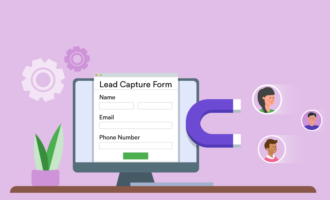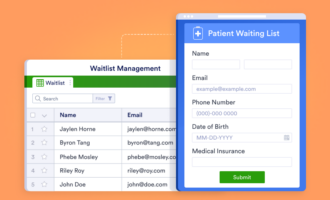Key Takeaways
- Lead generation is the process of converting potential customers of a certain product to leads and initiating their buyer journey.
- Lead generation has several methods, with inbound and outbound marketing being the most popular ones.
- With the digital revolution, online lead generation methods gained traction, such as emails, websites and social media campaigns.
- Not every lead is created equal, the lead quality concept defines the likeliness of a prospect to eventually convert.
- In order to learn the most important features of a lead, you can collect their crucial contact data via online forms.
- If you know your target audience well enough, you can also buy leads from certain resources.
What is lead generation?
Lead generation is the process of converting strangers — prospects that have indicated an interest in what you’re offering — into leads and starting them on the journey of becoming a customer.
There might be thousands of prospects out there who are aware of your brand, but until they engage with you in some way, they remain strangers to your company. How do you draw such targets in and capture their interest so that they’ll make themselves, and ideally their email addresses or phone numbers, known to you? Through lead generation.
After all, if you haven’t captured a prospect’s interest and figured out how to communicate with and identify them, you have no one to aim your marketing efforts at — no one to nurture toward purchase. That’s why it’s important you manage your lead generation practices well.
Lead Generation Through Online Forms
Start collecting leads with Jotform’s lead generation form templates.
Lead generation strategies: Key considerations and effective lead magnets
If lead generation is the process of converting strangers into leads, then a lead generation strategy refers to the approach you use to support and optimize this process. Essentially, it’s a plan of action to attract and capture leads.
Naturally, there are a number of concepts you need to understand and a range of decisions you have to make when building an effective lead generation strategy.
Lead generation approaches: Inbound marketing vs outbound marketing
One of the first decisions you’ll have to make when developing a lead generation strategy is whether you’re going to rely on inbound or outbound marketing tactics, or a mix of both.
Inbound marketing explained
The goal of inbound marketing lead generation is being found. These efforts rely on a strong digital presence.
Inbound marketing is the process of companies pulling in prospects organically by giving them something they’re actively looking for (something useful or educational, for instance). Organizations earn attention this way, and the prospective customer is the one who opens the lines of communication.
Examples: blog posts, organic social media posts, podcasts, opt-in emails, optimized content, YouTube videos
Outbound marketing explained
In contrast to inbound marketing, outbound marketing efforts focus on broadcasting messages to find prospective customers wherever they are. In this case, the organization buys or otherwise gets attention, and it’s the business that initiates communication, not the prospect.
Examples: Cold calling, which entails phoning a prospect you’ve had no prior contact with, is a key example of outbound marketing, and was once a popular tactic. As this methodology relies on making contact with cold leads (more on this below), it’s lost much of its efficacy today. That means that if you’re going to make use of this technique, it’s critical that you’ve mastered the art of cold calling first.
Aside from the above, other examples of outbound marketing include television, radio, and print advertisements; billboards; direct mail; and email blasts to purchased lists.
Outbound vs inbound: A direct comparison
| Outbound marketing | Inbound marketing | |
|---|---|---|
| Direction of focus | Outward | Inward |
| Approach | Push messages to customers | Pull customers to messages |
| Audience (scope) | Large and broad | Smaller and more targeted |
| Messaging specificity | Tends to be quite generic | Tends to be more personalized |
| Conversation dynamics | One-way conversation | Two-way conversation |
| Customer control | Low: Customers see messaging whether they’re looking for it or not | High: Customers seek out contact and messaging |
| Cost per lead generated | Tends to be higher (according to HubSpot, outbound leads cost 61 percent more than inbound leads) | Tends to be lower (as compared to outbound marketing) |
Offline lead generation: Why you shouldn’t neglect it
Offline lead generation remains a valuable complement to digital efforts, offering unique advantages like reaching offline audiences, building trust through face-to-face interactions at events like trade shows, and standing out in less saturated spaces. While digital strategies dominate, offline tactics can effectively engage less active online segments and provide a refreshing way to capture attention.
Examples of offline lead generation
Consider some of the following non-digital lead generation activities:
- Setting up a booth at a trade show
- Presenting at a seminar or conference
- Sponsoring an event
- Sending direct mail
- Publishing entertaining or educational content in print mediums (offline content marketing)
Lead generation, lead management, and the sales funnel
Lead generation is just one part of the broader process of individuals and businesses progressing from strangers to committed customers. The marketing-sales funnel, or the lead funnel, is a visualization of this process, and it indicates the various stages that consumers move through on their journey toward purchase. It’s meant to help marketing and sales professionals better understand where prospects are in this process and what information they might need to become customers.
To develop a sound lead generation strategy, you need to understand where this particular part of the process fits into the broader sales picture. It’s also vital to remember that marketing doesn’t stop at lead generation.
The importance of developing buyer personas for effective lead generation
Before you can pull in the kind of leads that are most likely to convert, you need to have a clear understanding of who you’re trying to attract in the first place. In other words, you need to grasp who your ideal customer is and what motivates them to buy. For this reason, creating buyer personas — research-based representations of customer types — is a critical early-stage step when developing a lead generation strategy.
Developing a sound understanding of your target audience will help you to
- Select the most appropriate lead generation channels
- Develop content that addresses targeted concerns and, therefore, is likely to be valued
- Personalize messaging for different audience segments
- Select appropriate lead magnets (see description further down)
- Determine which leads are more likely to convert — based on their similarity to the target audience — and, therefore, which prospects are worth nurturing (see more on qualifying leads below)
Questions to ask yourself when building buyer personas
- What’s our target customer’s income and education level?
- What are their key interests?
- Which social media platforms do they frequent?
- What compels them to buy?
- What are their biggest pain points?
- What’s their role in their company?
- Where do they look for information?
- How do they prefer to communicate?
- How much power do they have to make decisions (for B2B)?
- What are some of the key challenges in their industry (for B2B)?
Answer the above questions by conducting market research, surveying your existing customer base, conducting focus groups, and using analytics.
An overview of lead scoring: How to rank and qualify leads
How do you go about labeling a prospect as an MQL or SQL so you can target outreach accordingly? You use lead scoring to qualify leads.
In lead scoring, you assign points for different attributes and actions to determine a final score that indicates buying stage and purchasing intent. The higher the score, the closer to conversion the lead is.
You have to decide what weight (or point value) to give different qualities and behaviors, and you have to identify a score threshold for the promotion of a lead to MQL or SQL status. In bigger companies, this requires collaboration between marketing and sales teams. Once definitions are in place, many businesses then program lead scoring software to assign points and measure leads against benchmarks.
For the most part, businesses determine points based on
- Demographic information. How closely does the lead match your target B2C customer profile?
- Company information (in the case of B2B selling). How closely does the lead match your target B2B customer profile?
- Behavior on your website. Has the lead visited high-value pages? How many pages have they viewed?
- Email engagement. Does the lead frequently open your emails? Do they often click through from newsletters to your website?
- Social engagement. Does the lead regularly like, share, or comment on your social media posts?
What’s a lead magnet?
Prospective customers aren’t just going to hand over their personal information. You need to offer them something of value (beyond your product or service offering) in order to make this exchange fair. This “thing of value” is your lead magnet, so called because it attracts leads by giving them something they want or need.
Generally speaking, good lead magnets are specific, accessible, and easy to consume, and solve a defined problem or address a particular need, while positioning you as a thought leader in your field.
Just as your ability to capture leads depends on the strength of your lead magnet, it’s essential that you identify appropriate options early on while developing your lead generation strategy. What works will depend on the buyer personas you’ve developed and the type of offers that prospects are likely to find most valuable.
How to generate leads online
Once you’ve identified your lead magnets, use these four simple techniques to start driving, capturing, and nurturing your could-be customers to conversion.
Build a great lead generation website
- Forms should be one column, with one question per row (according to a Google eye-tracking study).
- Embed your form above the fold, so users don’t have to scroll down a page to view or complete it.
- Create a headline that encourages readers to take action.
- Don’t include too many fields in your form — and don’t ask for too much personal information. A study by HubSpot found that the conversion rate increases by 50 percent when the number of form fields decreases from four to three.
- Choose the color of your call-to-action button carefully. Research generally reports that red is best.
- Think twice about asking prospects for a phone number; asking for this information leads to the highest form abandonment rates. Consider making this an optional requirement if you must collect this information.
- Opt-in Form for Free Email Updates
- White Paper Download Form
- Webinar Signup Form
- General Inquiry Contact Form
- Referral Program Form
Dial in your email marketing and think carefully about cold email from purchased or rented lists
Leverage the power of social media
- Creating posts that send users to a landing page with a lead capture form and lead magnet
- Embedding lead capture forms in an actual social post, company page, or ad
- Encouraging prospects to follow your social account
- Event registrations.
- Newsletter signups.
- Quote requests.
Use the best lead generation software and tools out there
Jotform
Callingly
HubSpot
Pipedrive
Your website is ground zero in the lead generation process, with 63 percent of consumers reporting that it’s their preferred port of call when searching for and engaging with a brand.
Beyond just providing information about who you are and what you offer, this all-important marketing channel is where you capture your leads via a lead capture form.
This form can come in all shapes and sizes, but its primary purpose is to collect potential customer contact information in exchange for your lead magnet so that you can continue to market to — and ideally convert — leads into buyers.
However you decide to capture leads — and regardless of what information you deem most important to collect, it’s essential to make sure the lead generation forms on your website are optimized and fully functional.
Just so you know
Start generating more leads for your business with Jotform’s free online lead-gen forms, contact forms, and signup forms.
How to optimize a lead generation form
There was a time that creating and embedding lead capture forms on your site required the know-how of a development team, but these days, services like Jotform have revolutionized the process, making it easy for anyone to create and publish forms on their website in only a matter of minutes.
With technical difficulties removed, you can really focus on optimizing your lead generation form to get the best possible results. Here are six best practices that can help you put together a lead capture form that converts:
5 lead generation form templates for your website that really convert
Year after year, email proves to be the top channel for generating high-quality leads, offering a cost-effective solution for marketers—when done correctly.
Start with a strategy
Focus on building an opt-in contact list rather than buying or renting email lists. Purchased lists are often unreliable, may violate laws like the CAN-SPAM Act, and can harm your brand reputation. Instead, use lead magnets such as how-to guides, webinars, or white papers to provide value and encourage prospects to voluntarily share their contact information.
Personalize and segment
Once you’ve captured leads, use demographic and behavioral data to create personalized marketing pathways. Tailor your emails—including subject lines, content, and calls to action—to resonate with each segment. Develop a sequence and timeline that aligns with your audience’s needs, testing and optimizing as you go.
Leverage CRM tools
CRM software can streamline lead tracking, scoring, and nurturing. By automating data collection and the lead generation process, these tools ensure your messaging reaches the right person at the right time, maximizing the impact of your email marketing campaigns.
By focusing on value, personalization, and strategic use of tools, you can turn email marketing into a powerful driver of conversions and ROI.
Social media — like Facebook, Instagram, LinkedIn, and Twitter — is another great lead generation tactic. Over 66 percent of marketers agree that as little as six hours a week spent on social media campaigns can have huge lead generation benefits.
When it comes to lead capture via social media, there are three primary ways to collect information from users:
Some platforms, like Instagram, don’t yet have the functionality to embed lead capture forms, but others, like Facebook and LinkedIn, have a few different embedding options. We’ll explore these in more depth below.
Facebook lead ads
Back in 2015, Facebook made it faster and easier for companies to market to their more than 1 billion users with the advent of lead ads.
These mobile-friendly ads allow users to click and complete prepopulated lead capture forms based on their Facebook profile. The forms can also sync with CRMs, enabling instant sales follow-ups.
Common uses of Facebook lead ads:
Finally, if you’re a small business that doesn’t have a CRM, you can download your leads from the Facebook ad manager.
LinkedIn Lead Gen Forms
For B2B marketers in particular, LinkedIn is an invaluable lead generation source. Thanks to LinkedIn Lead Gen Forms, companies can capture high-quality leads at scale without having to divert users from the social media platform to their website.
Like Facebook’s Lead Ads, this business-centric platform gives brands the opportunity to capture contact information with just a few clicks on some carefully created ads (for example, something that promotes a webinar or an e-book download). LinkedIn Lead Gen Forms also integrate with CRMs and give marketing professionals the opportunity to download leads from the tool’s Campaign Manager.
Last, thanks to in-platform analytics, it’s easy to measure the efficacy of your campaigns by examining cost-per-lead metrics and form fill rate metrics.
Here are some of the best tools, that tried to provide different options for different levels of business maturity.
This powerful and affordable online application makes it lightning fast and super easy to create custom lead capture forms and embed them on your website — no coding experience required.
While Jotform is ideal for any size business (it has special options for enterprise-level organizations), it’s especially useful for startups, nonprofits, and entrepreneurs who need a simple way to collect client or customer contact information.
Jotform has a number of pricing options, including a free starter plan, and each of the fee structures gives you access to all of the application’s features.
Callingly is a lead generation tool that facilitates this process, automatically triggering connections between sales reps and hot could-be customers as soon as a lead comes in.
The service syncs with any CRM as well as applications like Jotform, and it collects important analytics so you can track and improve call performance.
Callingly is ideal for small and growing businesses, but it does have an enterprise-level pricing option (as well as a free trial).
Now a household name in the inbound game, HubSpot is perhaps the most widely known marketing software in the business. The company’s all-in-one tool is committed to helping organizations big and small grow their traffic, convert leads, and track prospects through the sales funnel.
Beyond just lead tracking, scoring, and management functionality, HubSpot gives companies the ability to build landing pages, lead forms, lead generation content, and full-fledged email marketing campaigns.
There is both a free option and a considerably more robust professional version that comes with over 30 additional features.
Pipedrive bills itself as the “first sales CRM designed by salespeople for salespeople,” and true to form, it boosts sales efficiency by identifying the most qualified leads and making it easy for salespeople to reach out to, connect with, and continue to communicate with promising prospects.
Pipedrive comes with extensive reporting and forecasting features, and its mobile functionality allows users to access the information they need from anywhere and at any time.
Pipedrive has a number of different pricing options, which makes it ideal for both growing businesses as well as heavyweights in any industry.
Methods for B2B lead generation
B2B and B2C marketers share a common challenge: finding high-quality leads that are likely to convert at the lowest possible cost. However, B2B marketing has distinct characteristics that set its lead generation and nurturing process apart from B2C.
Key differences in B2B lead generation
- Longer Sales Cycles
B2B sales typically take longer, with many marketers spending one month to a year engaging leads before securing a commitment. - Multiple Decision Makers
B2B sales often involve multiple stakeholders—sometimes as many as seven—requiring a broader lead generation strategy targeting diverse buyer personas. - Detailed Lead Information
Capturing specific data at the point of lead generation is essential. Information such as business size, type, price preferences, and job function helps tailor the marketing approach for each persona during the lead nurturing process. - Unique Prospecting Channels
B2B marketers are more likely to find success through trade shows, industry conferences, or professional networks, rather than consumer-oriented methods like direct mail or general advertising.
Best B2B lead generation channels
According to data from researchers at Kellogg School of Management at Northwestern University and the Spiegel Research Center, B2B marketing professionals report that they have more success with blog posts and articles, webinars, white papers, branded digital content, video, and images.
Conversely, in-person seminars and workshops, once regarded as highly effective, seem to be less popular and less effective among today’s busy decision makers and purchasers.
B2B marketers also report that the most common channels for finding leads are email, search, and digital content. More than 50 percent of B2B marketers cite email as the most prevalent source of leads as well as the channel with the most effective and efficient return on investment, the most reliable source of lead generation and nurturing, and the most effective method of conversion from lead to sale.
SEO-friendly lead generation
Effectively optimizing your website according to SEO best practices can be a complicated and ever-evolving endeavor.
That’s because major search engines, like Google, constantly adjust how they prioritize and rank websites, which means you’ll need to keep up to date with critical changes and make sure your website puts these new developments into play as they roll out.
The structures search engines already have in place to evaluate websites function according to a robust mix of technical, editorial, and outreach fundamentals. To leverage the power of search and ensure this marketing channel is operating at its best, it’s key to understand how all of these components work together and what you need to do to check all the right boxes.
How to optimize your website with 5 SEO best practices
That said, there are a few tried-and-tested practices that you can apply to your website to generate traffic and leads relatively quickly.
1. Make sure your website can be crawled and indexed
First and foremost, make sure that your website is discoverable to search engines. In SEO speak, that means that your website should be crawlable and indexable.
The most important steps you can take to ensure a crawlable and indexable website are making your site’s navigation clear and easy to follow and not having robots directing search engine crawlers to ignore certain pages.
2. Identify keywords and generate relevant and compelling content
Keywords, or search queries, are the terms that internet users type into a search engine to find relevant pages. To drive the right kind of traffic to your website, determine which keywords best align with your business and your audience’s interests.
To generate this list, start by brainstorming the kinds of topics people would search for when looking for information about your product or service offering. You may also want to examine the kind of information competitors have in order to refine this list.
3. Understand key places of prominence and tailor content accordingly
When search engine bots crawl your site, they investigate the data to get a clear idea of what your pages are about and how relevant they are to particular keywords.
One way they do this is by examining key places of prominence on a page, like a title tag, header tags, and the first 100 words of content, to see if your keyword — and other related topics — are included.
Make sure you have a clear idea of the key places of prominence and have written keyword-rich content to insert into these areas.
4. Create a great user experience
Recently, search engines have started to find ways to measure and evaluate websites based on their user experience, which is, in a nutshell, how easy it is to use your site.
One of the top ways they evaluate user experience is page speed, which is how fast your website loads and appears for users — both from a desktop and mobile perspective.
5. Build links, build links, build links
One of the most important parts of optimizing your website is making sure that other websites link back to your content pages. That’s because Google and other search engines use the number of links that lead back to your site (and the quality of the domains from which these links originate) as a critical measure of how reputable and relevant your website is.
As with all marketing efforts, measuring your efforts and constantly refining them is key to success.
Why bother with lead generation? Tracking-led conversion
Once you start generating leads, you should begin analyzing them at various steps in the marketing-to-sales lead nurturing process in order to prioritize them, more effectively evaluate the success of your lead generation efforts, and ultimately optimize your campaigns to perform better and more efficiently.
Two key approaches to lead tracking
There are two main ways to think about lead tracking: volume and quality.
- Volume Tracking
Measure the number of leads generated at each stage of your funnel. This helps identify drop-off points, areas for improvement, or the need to expand efforts to attract more leads early in the process.- Key Metrics: Total leads, leads per channel, and conversion rates per channel.
- Channel-Specific Metrics:
- For email marketing: delivery rates, open rates, unsubscribe rates, and click-through rates.
- For content marketing: page visits, call-to-action clicks, time on site, and time-to-conversion rates.
- Quality Tracking
High-quality leads, or those most likely to convert, are critical for B2B and high-value B2C products. Focus on these lead quality metrics:- Demographics: Gathered through forms in exchange for valuable content like webinars, identifying shared characteristics among converted leads.
- Social Engagement: Measured by mentions of your brand or content shares.
- Fitness: Points assigned for alignment with target customer profiles (e.g., location, business size, or revenue).
- Interest: Gauged by tracking downloads, additional data submissions, or product inquiries.
Lead scoring and conversion analysis
Lead scoring assigns categories and values to leads at the start of the process, refining these as leads move through the funnel. This helps prioritize nurturing efforts for high-potential leads.
To further optimize, measure the cost of conversion by tracking:
- Resources and time spent per lead.
- Time between clicks or actions within the funnel.
- Steps required to progress a lead to conversion.
By adopting a data-driven approach, you can improve efficiency, focus on the leads most likely to convert, and maximize your return on investment.
Lead scoring and audience segmentation
Lead scoring is the practice of assigning numerical values to leads using a scale from “merely interested” to “ready to make a purchase,” with the goal of determining a target score that will indicate when a lead needs to transition from marketing to the sales team.
It’s important that sales and marketing use the same metrics for lead scoring. Sales and marketing also need to agree on when and how to measure in order to assign point values. You can also track costs per lead and other aspects of lead generation to more efficiently allocate resources and make necessary adjustments and improvements.
A/B testing and other forms of lead analysis
Testing is another way of applying an analytical framework to adjust and improve your lead generation and nurturing processes. A/B testing involves changing one aspect of a lead magnet, for example, a headline on a landing page, sending one version at random to one half of your audience and the other version to the other half, and then analyzing conversion to lead rates to determine which version is most effective.
Buying and selling leads
Like anything of value, leads can be bought and sold. However, just because you can purchase leads doesn’t mean you should.
The pros and cons of buying leads
While buying leads can save time and effort at the top of the funnel, it comes with significant risks.
Advantages:
- Suitable for startups or small teams without a dedicated marketing/sales team.
- Useful when traffic to your digital platforms is low or stagnant.
Disadvantages:
- Often more expensive and less effective than in-house generated leads.
- Purchased leads are not organic and may feel intrusive to recipients.
- May harm your reputation if leads feel their data was misused.
- Risk of being flagged as spam, which can damage your IP reputation and marketing efforts.
Lead-buying sources
If you decide to buy leads, opt for reputable providers, such as:
| Product | Features |
|---|---|
| UpLead | Focused on B2B, allows lead information integration with most CRM systems |
| FineEmails | Verified email lists at an affordable price |
| D&B Hoovers | Sales leads generated through Dun & Bradstreet’s robust database |
| Salesfully | Simple, affordable, regularly verified lead list |
| LinkedIn Sales Navigator | Provides contact information for decision makers |
Selling leads
Selling leads can be a lucrative strategy if done responsibly.
When to consider selling leads:
- You have verified, unused leads that don’t align with your business model.
- You’re closing your business but have a pipeline of leads.
- You want to start a lead generation business with minimal startup costs.
Challenges of selling leads:
- Leads may be sold to irrelevant or unethical businesses, harming your reputation.
- Diverts time and resources away from core business activities.
- Selling untested leads may miss untapped opportunities.
How to sell leads
Once you’ve weighed the pros and cons and decided you want to try to sell leads, it’s time to create a process for gathering, categorizing, and pricing your leads.
Categorize and price leads:
Leads that opt into your content streams voluntarily are more valuable.
Build a buyer network:
- Contact competitors if shutting down a business.
- Work with reputable lead brokers via resources like the Association of National Advertisers.
Ensure GDPR compliance:
GDPR regulations require explicit consent before collecting or sharing EU citizen data. Violations can result in fines up to 20 million euros or 4% of global revenue.
Revise your privacy policy and terms to disclose the potential sale of data.
Jotform makes this easy by providing a self-serve Data Processing Addendum that users can agree to and that will keep you GDPR compliant. For more information on GDPR, visit eugdpr.org. You may also want to seek the advice of an attorney with knowledge of international privacy laws.
Buying and selling leads requires careful consideration, compliance with data protection laws, and a clear strategy to ensure ethical and effective lead management. Focus on transparency, user consent, and building long-term trust with your leads.
























































Send Comment:
4 Comments:
More than a year ago
Hi,
Lead Generation is extremely important when it comes to growing our business therefore I personally use Aeroleads and prefer it to everyone because it’s the best software that helps me to find phone numbers, email addresses, and social media profiles of individuals and businesses.
It also helps with Linkedin prospecting. AeroLeads will add leads to email marketing lists, so you can start working on those leads right away.
If anyone is confused to choose the best website for collecting contacts so you can definitely go with Aeroleads.
More than a year ago
This article is AWESOME. I can't believe the step-by-step instruction you give for lead generation. This is the type of content that seems like it should be a white paper requiring an email address! Thanks again for an excellent article on lead generation.
More than a year ago
I really love how detailed your article was, great job. I just wanted to drop a comment and let you know that the blog is really informative and worth reading. Keep sharing about lead generation.
More than a year ago
Anyone who worked in a sales business would know the value of a qualified lead in a heartbeat. Having multiple of them would give you all you need to work on, after that you'll just have to work your charm and magic to close the sale.
Therefore generating those leads in the first place means that you are halfway there on putting some money in your company's safe. That leads to the importance of focusing your efforts on finding or creating those leads. In my insurance business, I start with the same training for all of my new agents: lead generation methods and importance.
A well-researched lead would eventually end up as an advocate of your company and that is pretty valuable. That's why I liked the infographic about possible ways to get your ordinary customer to become an advocate in section 6.
To all newcomers into the sales arena, I cannot emphasize the importance of a lead enough, make sure to do your research well, and select the best way of lead generation for your business!